Update on installation of the river basin murals and the audios that tell their stories
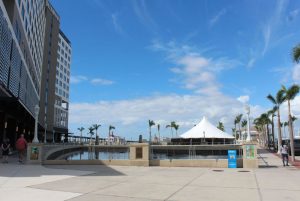 As February draws to a close, work continues on the Fort Myers River Basin Mural Project. That’s a collaboration between the City’s Public Art Committee, Community Redevelopment Agency and the Fort Myers Mural Society to create an outdoor, walkable art and history museum that features 57 murals which tell the tale of Fort Myers’ early existence as a port on the
As February draws to a close, work continues on the Fort Myers River Basin Mural Project. That’s a collaboration between the City’s Public Art Committee, Community Redevelopment Agency and the Fort Myers Mural Society to create an outdoor, walkable art and history museum that features 57 murals which tell the tale of Fort Myers’ early existence as a port on the 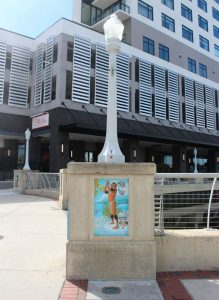 Caloosahatchee River. Painted on specially-manufactured mural cloth by 38 area artists, the panels are being installed on the concrete pillars or stanchions and four obelisks that encircle the detention basin adjacent to Luminary Hotel.
Caloosahatchee River. Painted on specially-manufactured mural cloth by 38 area artists, the panels are being installed on the concrete pillars or stanchions and four obelisks that encircle the detention basin adjacent to Luminary Hotel.
Proposed last May, the artists were given 100 historic photographs, postcards and related images in September, and in spite of the damage and losses that many of the artists suffered during Hurricane Ian, most completed work before Thanksgiving.
Installation started in December. Today, 43 of the 57 murals are now in place on the stanchions.
At the same time, 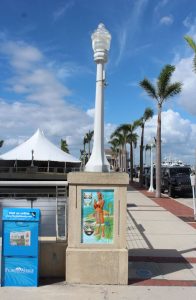 artist bios, photographs – including the historic images the artists referenced in creating their paintings – and audios providing historical context have been uploaded to a free mobile app called Otocast that anyone can download and enjoy. So far, audios 17 of the 43 installed murals are live on the app.
artist bios, photographs – including the historic images the artists referenced in creating their paintings – and audios providing historical context have been uploaded to a free mobile app called Otocast that anyone can download and enjoy. So far, audios 17 of the 43 installed murals are live on the app.
Here’s a summary of what you will find on Otocast, and whether you choose to view and listen to the material in the comfort of your home or as you and your bestie or cru stroll the sidewalk that surrounds the river basin either before or following breakfast, brunch or lunch and a drink, you’ll be amazed by the stories you’ll hear – and absolutely want to share with everyone you know:
Mural #3 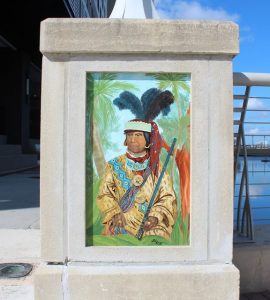 depicts Alligator Chief Billy Bowlegs during the Second Seminole War. The audio describes the role this great warrior played during the Army’s campaign to remove the Seminoles and other tribes from the Florida peninsula between 1835 and the war’s end in 1842. This portrait was painted by Sherry Lynn Diaz.
depicts Alligator Chief Billy Bowlegs during the Second Seminole War. The audio describes the role this great warrior played during the Army’s campaign to remove the Seminoles and other tribes from the Florida peninsula between 1835 and the war’s end in 1842. This portrait was painted by Sherry Lynn Diaz.
Mural #4 depicts Billy Bowlegs during the Third and final Seminole War. The audio for this mural tells the tale of how Bowlegs and the last of Florida’s Indigenous people resisted the Army’s attempts to forcibly remove them from the Everglades and deport them to a reservation in Oklahoma. This 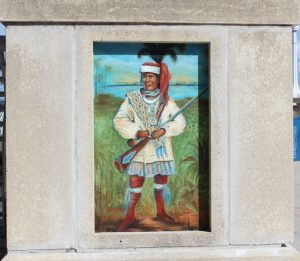 figurative work comes compliments of Lorrie Bennett.
figurative work comes compliments of Lorrie Bennett.
Mural #5 is of a Miccosukee warrior by the name of Billy Fuel who fought alongside Billy Bowlegs. Living to the ripe old age of 118, Billy could occasionally be spied walking down First Street when he and fellow tribesmen would come to town to trade pelts and other items with Fort Myers merchants like R.A. Henderson. This mural is the product of popular local artist 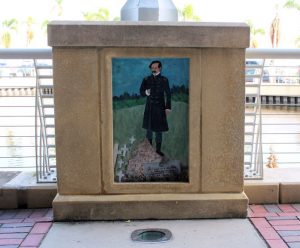 and art teacher Eric Riemenschneider.
and art teacher Eric Riemenschneider.
Mural #6 is Claudia Goode’s rendition of the town’s namesake, Colonel Abraham C. Myers. If you’ve wondered who Fort Myers was named for – and how and why – then you’re really going to enjoy the Otocast audio for this panel. As for Ms. Goode, not only is she a talented artist, but you probably recognize her as the long-time manager and curator of 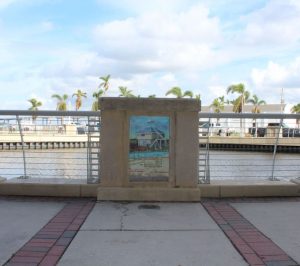 Arts for ACT Gallery in the Arcade Building on First.
Arts for ACT Gallery in the Arcade Building on First.
Mural #7 is Rod Acosta’s painting of a map of the actual fort, along with one of the blockhouses that anchored the stockade during both the Third Seminole and Civil Wars. The audio for this mural is a real eye-opener. For instance, did you know that during the 1850s, the fort was not only the most expensive frontier outpost in the country, it even had a 500 foot pier and bathing pavilion and an outdoor bowling alley 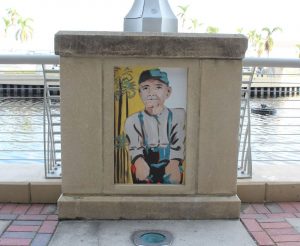 sandwiched between two immense vegetable gardens.
sandwiched between two immense vegetable gardens.
Mural #9 is Tarek Patton’s folk art portrait of Evalina Gonzalez. Not only did she play an instrumental role in the decision to settle Fort Myers in 1866, she became Fort Myers’ first schoolteacher when she decided to homeschool her own and the neighbors’ kids.
Mural #10 depicts Evalina’s brother, John Alexander Weatherford, 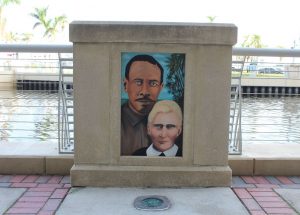 who was one of Fort Myers’ first four settlers, arriving on the grounds of the old fort on February 21, 1866 with his brother-in-law, Manual A. Gonzalez, five-year-old nephew, Manual S. and their close family friend, Joe Vivas. This portrait came from the easel of local artist Lesley Morrow.
who was one of Fort Myers’ first four settlers, arriving on the grounds of the old fort on February 21, 1866 with his brother-in-law, Manual A. Gonzalez, five-year-old nephew, Manual S. and their close family friend, Joe Vivas. This portrait came from the easel of local artist Lesley Morrow.
Mural #11 is Dawn Webb’s double portrait of our town’s first Black settler 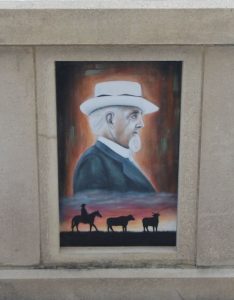 and interracial couple, Nelson and Ellie Tillis. The voice of Fort Myers public art, Bill Taylor, tells their incredible story in the Otocast audio that accompanies this mural panel.
and interracial couple, Nelson and Ellie Tillis. The voice of Fort Myers public art, Bill Taylor, tells their incredible story in the Otocast audio that accompanies this mural panel.
Painted by talented realist and tattoo artist Samantha Taylor, Mural #12 depicts cattleman Francis Asbury Hendry, who captained a company of Confederate militia that attacked Fort Myers during the waning days of the Civil War. It’s true. Fort Myers was a Union outpost during the War Between the States, and the audio for this mural not only tells you why, but what F.A. did to earn the moniker of Father of Fort Myers.
Mural #13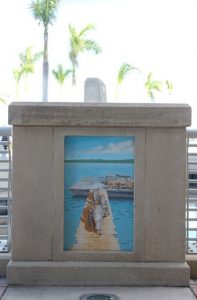 is a joint effort by husband-and-wife artists Roland Ruocco and Wendy White. It shows drovers unloading cattle from a barge upriver near Olga. This panel is a homage to the important role that the cattle industry played in the town’s settlement and growth between 1873 and the town’s makeover as a tourist destination in the early 1900s.
is a joint effort by husband-and-wife artists Roland Ruocco and Wendy White. It shows drovers unloading cattle from a barge upriver near Olga. This panel is a homage to the important role that the cattle industry played in the town’s settlement and growth between 1873 and the town’s makeover as a tourist destination in the early 1900s.
Mural #35 is a painting of the steamboat that launched the careers of steamboat captains Andrew and George Kinzie, who owned and operated one of the three steamship companies that served Fort Myers and all of Southwest Florida well into the 1930s. The St. Lucie comes from the hand of local artist Alex Wilkinson.
Mural 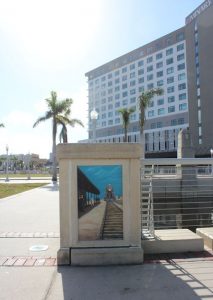 #36 depicts the first train to arrive in Fort Myers. Our town lagged behind other cities when it came to rail service. The railroad didn’t come here until 1904. While the first couple of trains to pull into the depot were modest affairs, there was one that came in June of that year that had the barkeeps on both saloons keeling over with exhaustion. That story, and others, are told on Otocast. Danilo Rubias painted this important piece.
#36 depicts the first train to arrive in Fort Myers. Our town lagged behind other cities when it came to rail service. The railroad didn’t come here until 1904. While the first couple of trains to pull into the depot were modest affairs, there was one that came in June of that year that had the barkeeps on both saloons keeling over with exhaustion. That story, and others, are told on Otocast. Danilo Rubias painted this important piece.
Local artist Michelle McDonald painted Mural #42, which depicts guests arriving on the 1,500 foot pier downriver at Thomas Edison’s Estate. The Otocast audio for this painting tells the charming story of how the great inventor regularly took time away from his experiments to enjoy life on 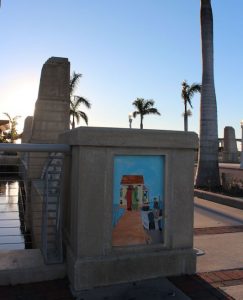 the water.
the water.
Mural #44 is of Henry Ford sitting in a 1916 Model T on one of the town’s eight long piers. That car is still in town today. Ford gave it to Edison as a birthday present, and Tom never parted with it. You can see it on display at the Edison & Ford Winter Estates. We have automotive artist Ruben Dimas to thank for this beautiful artwork.
Mural #45 comes from pop artist, arts advocate and DAAS Co-Op co-founder David Acevedo. It’s a painting of the first steamship to travel with passengers from the Atlantic Ocean to the Gulf of Mexico via the cross-state waterway that was a dream 371 years in the 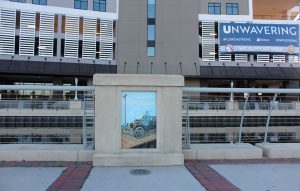 making.
making.
Mural #50 is Artsemble Artist Brian Weaver’s painting of a vintage Gator Hunt postcard. As you’ll hear in the Otocast audio for this mural, not everyone came to Florida to catch tarpon or sunbath on the beach.
Mural #53 is Wendy White’s Fun in Florida mural, based 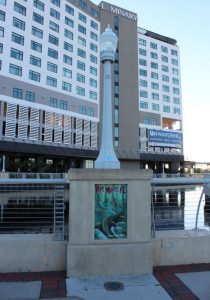 on another vintage postcard from the 1930s. As the audio for this mural relates, no one knows when the first postcard promoting Fort Myers and its various hotels and attractions first appeared in print, but between 1913 and the start of World War II thousands of white-bordered linen stock postcards promoting Fort Myers to the outside world were mailed by residents, shopkeepers and vacationers to family, friends and business associates around the world.
on another vintage postcard from the 1930s. As the audio for this mural relates, no one knows when the first postcard promoting Fort Myers and its various hotels and attractions first appeared in print, but between 1913 and the start of World War II thousands of white-bordered linen stock postcards promoting Fort Myers to the outside world were mailed by residents, shopkeepers and vacationers to family, friends and business associates around the world.
The audios for these 17 murals will give listeners a better feel for what makes Fort Myers so special and the trials and tribulations that explain just how and why we have the resilience, individually and collectively, to overcome the destruction and challenges that Hurricane Ian has thrown in our path. 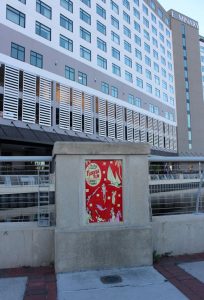 With what we’ve faced in the past, the challenges we’ve surmounted, recovering from Ian is in our heritage and genetic make-up.
With what we’ve faced in the past, the challenges we’ve surmounted, recovering from Ian is in our heritage and genetic make-up.
More artist bios, photos and audios will be added to Otocast in the coming weeks and months. And the rest of the murals will be installed on the stanchions and obelisks encircling the river basin as soon as the City fixes those that were damaged by Ian back on September 28th.
February 25, 2023.
RELATED POSTS.
- Identifying river basin murals and muralists
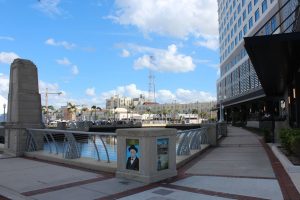 Audio for Lesley Morrow’s mural of early settler John Alexander Weatherford now live on Otocast
Audio for Lesley Morrow’s mural of early settler John Alexander Weatherford now live on Otocast- Spotlight on River Basin muralist Lesley Morrow
- Audio for Billy Bowlegs murals at Fort Myers River Basin now live on Otocast
- Audio for Eric Riemenschneider’s ‘Billy Fuel’ mural now live on Otocast
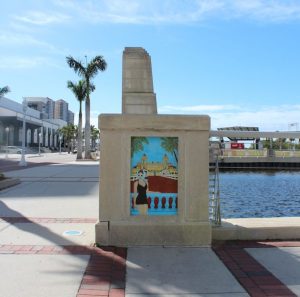
- Audio for Rod Acosta’s ‘Block House and Survey Map’ mural now live on Otocast
- Audio for Tarek Patton’s mural of Evalina Gonzalez is now live on Otocast
- Audio for David Acevedo’s ‘City of Palms Steamship’ mural now live on Otocast
- Audio for Brian Weaver’s ‘Gator Hunt’ mural now live on Otocast
- Audio for Wendy White’s ‘Fun in Florida’ mural now live on Otocast
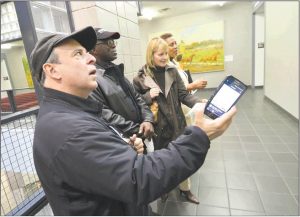 Audio for ‘Female Fruit Vendor’ now live on Otocast
Audio for ‘Female Fruit Vendor’ now live on Otocast- Audio for IMAG’s ‘Man Playing Flute’ now live on Otocast
- Audio for IMAG’s ‘Boy Fishing from Bucket’ now live on Otocast
- Audio for Franklin Shops’ ‘Two Drunks on a Bench’ now live of Otocast
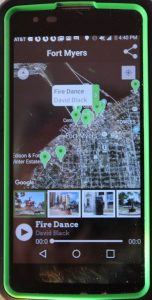 Audio for Collaboratory’s ‘Ribbon Routine’ now live
Audio for Collaboratory’s ‘Ribbon Routine’ now live- Garden Council past president Kay Holloway records Otocast audio for 1880 statue ‘Lorelei’
- Edison Ford Executive VP and author Mike Cosden records Otocast audio for ‘Uncommon Friends’
- Freelance writer, author and SWFHS President Glenn Miller records Otocast audio on Wes Nott
- Civil rights activist and musical instructor Reginald Billups records Otocast audio for USCT 2nd Regiment Monument
- River District Alliance Director and author Jared Beck records Otocast audio for Tootie McGregor Fountain
- Albert Paley records Otocast audio for his Riviera-St. Tropez sculpture, ‘Naiad’
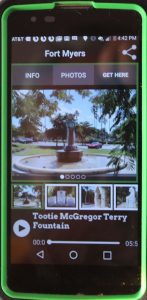 Author-historian Gerri Reaves records Otocast audio for ‘The Spirit of Fort Myers’
Author-historian Gerri Reaves records Otocast audio for ‘The Spirit of Fort Myers’- Muralist Barbara Jo Revelle records Otocast audio that tells all about downtown ceramic tile mural
- Maryland artist Cheryl Foster records Otocast audio for her Clemente Park sculpture
- IMAG History & Science Director Matt Johnson records Otocast audio














 Tom Hall is both an amateur artist and aspiring novelist who writes art quest thrillers. He is in the final stages of completing his debut novel titled "Art Detective," a story that fictionalizes the discovery of the fabled billion-dollar Impressionist collection of Parisian art dealer Josse Bernheim-Jeune, thought by many to have perished during World War II when the collection's hiding place, Castle de Rastignac in southern France, was destroyed by the Wehrmacht in reprisal for attacks made by members of the Resistance operating in the area. A former tax attorney, Tom holds a bachelor's degree as well as both a juris doctorate and masters of laws in taxation from the University of Florida. Tom lives in Estero, Florida with his fiancee, Connie, and their four cats.
Tom Hall is both an amateur artist and aspiring novelist who writes art quest thrillers. He is in the final stages of completing his debut novel titled "Art Detective," a story that fictionalizes the discovery of the fabled billion-dollar Impressionist collection of Parisian art dealer Josse Bernheim-Jeune, thought by many to have perished during World War II when the collection's hiding place, Castle de Rastignac in southern France, was destroyed by the Wehrmacht in reprisal for attacks made by members of the Resistance operating in the area. A former tax attorney, Tom holds a bachelor's degree as well as both a juris doctorate and masters of laws in taxation from the University of Florida. Tom lives in Estero, Florida with his fiancee, Connie, and their four cats.